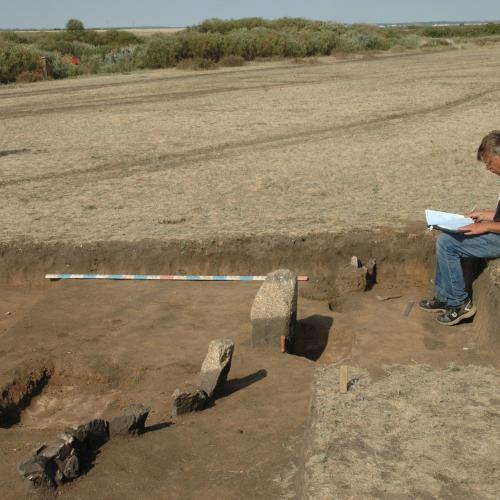Степные мегалиты до сих пор являются одним из самых загадочных сооружений, возведенных человеком в Урало-Казахстанской степи. Археологи считают, что камни устанавливались в качестве культовых сооружений.
Памятник был выявлен Г.Б. Здановичем в 2005 году и исследован Д.Г. Здановичем в 2016 году при раскопках сарматского погребения С-IV.
На современной поверхности площадка обозначена выступающими на 5-10 см верхушками камней и ограничена западным и восточным менгиром. Камни вытянуты по линии юго-восток – северо-запад более чем на 80 м. Раскопки показали, что некоторые камни соединены между собой небольшими каменными выкладками. В ходе раскопок вокруг восточного камня были выявлены две ямки, одна из которых содержала остатки кальцинированных костей, оставшихся после сожжения тела человека или животного. Исследователи предполагают, что на этом месте была ритуальная площадка эпохи поздней бронзы.
The Menhir Complex (S-5)
S-5 is a linear stone structure which was discovered in 2005 by G.B. Zdanovich and partially excavated in the course of a joint expedition by the Charitable Foundation “Arkaim”, the “Arkaim” Reserve, and Chelyabinsk State University in 2016. The expedition was directed by G.B. Zdanovich while the excavation was supervised by D.G. Zdanovich.
At present, the structure is identified by the stone tips sticking out 5-10 cm above the ground. There are 10 stones in total. The line of stones extends for more than 80 m in the NW-SE direction along the first river terrace border. The menhirs, which occur in cluster of 2-3 stones, delimit an area located just south of the BSK. The three easternmost stones are situated near the southwestern border of the Big Flat Burial Complex (SM). Two western stones (No. 3,4) are situated in the direction that coincides with the western side of the rectangular BSK ditch, while stones No. 1,2 continue the line westward.
The excavations of the eastern and western edges of the menhir line exposed vertically upright 0.8-1.0 m high stones. The largest menhirs were accompanied by arrangements of smaller stones. Underneath the easternmost menhir archaeologists found a small pit that contained fragmented calcined bones belonging to a human or an animal. In the western part of the menhir line, near the bottom of one of the stones, excavations exposed a small pit containing charcoal and soot. Archaeologists think the menhir line helped outline a ritual plaza delimited by the BSK and the Big Flat Burial Complex (SM).



